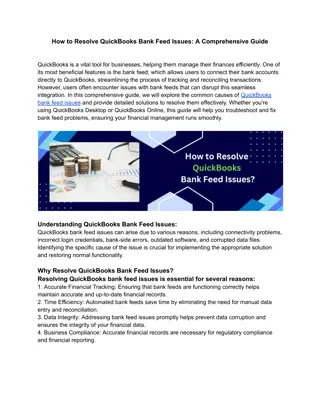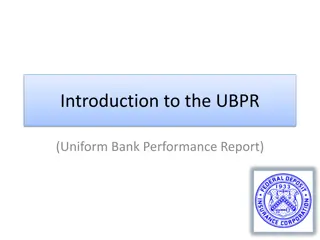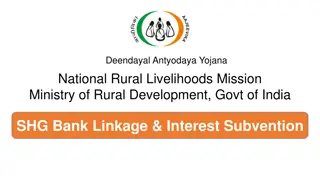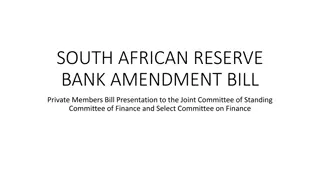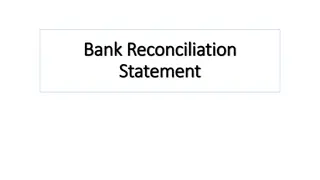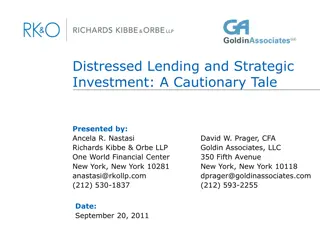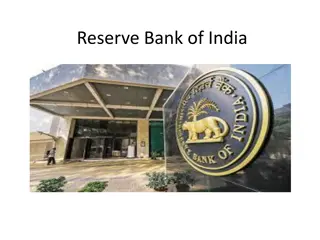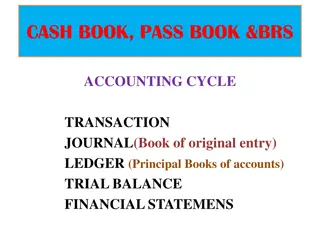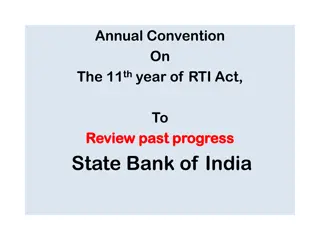Understanding the Impact of Distressed Bank Takeovers
The study delves into the complex dynamics of takeovers of distressed banks, highlighting the implications for acquiring banks' profitability and liquidity. It scrutinizes the contrasting views on mergers and acquisitions in the banking sector and examines a case study of Vietnam's banking system during 2011-2015. Through empirical analysis, the research sheds light on the consequences and trade-offs associated with such takeovers.
Download Presentation

Please find below an Image/Link to download the presentation.
The content on the website is provided AS IS for your information and personal use only. It may not be sold, licensed, or shared on other websites without obtaining consent from the author. Download presentation by click this link. If you encounter any issues during the download, it is possible that the publisher has removed the file from their server.
E N D
Presentation Transcript
Difficult to Digest: Takeovers of Distressed Banks Giang PHUNG, Paris 1 & ESCP Europe Michael TROEGE, ESCP Europe
Table of content 1. Motivation & Overview 2. Theoretical background 3. Data & Methodology 4. Result 5. Robustness 6. Conclusion
1. Motivation & Overview Takeovers of distressed banks implicit bailouts Takeovers of distressed banks (usually government-induced) are frequently used to stabilize a financial system without explicitly bailing out a bank. Our study shows that: these takeovers substantially weaken the profitability and liquidity of the acquiring banks this negative effect persists over a prolonged period of time 3
2. Theoretical background M & A in the banking system Opposing views: Acquire to restructure hypothesis: the takeover of failed banks by solvent institutions can reinforce stability (Perotti and Suarez, 2002), and enhance profitability (Caiazza et al., 2012) Concerned for the concentration-fragility hypothesis, TBTF: significant increase contribution to systemic risk (Wei et al., 2014), post-merger SIFIs undermine financial stability (Gomez, 2015), safety-net subsidies (Behr and Heid, 2011) 4
2. Theoretical background Vietnam s 2011-2015 banking M & A program Forced and voluntary mergers GFC 2008 had important consequences for Vietnam: Numerous emergency loans from the SBV providing short-term liquidity Commercial banks could avoid instantaneous failures, but the bad debts crisis was declared in 2011 The government approved the restructuration of the credit institutions system in the period 2011 2015. Followed acquire to restructure hypothesis: 11 mergers, expected to be an effective measure to recover weak banks 1) voluntary mergers among healthy banks, 2) voluntary acquisitions of a bank in difficulties by a healthy bank, 3) forced takeovers of distressed banks by the SBV Do the advantages outrank the drawbacks in these mergers? Bad debts recovery vs. a quick increase in market share and customer network 5
3. Data & Methodology Empirical Strategy Random-effect Regressions of Operation/ Profitability and Liquidity ratios on banks acquiring status dummies, ownership, and control variables ??????????????,?= ? + ?j(?????????j)?,?+ ??,?,?Controls?,?+ ??,? ? Eq. (1) ??????????,?= ? + ?j(?????????j)?,?+ ??,?,?Controls?,?+ ??,? ? Eq. (2) 6
3. Data & Methodology Data set Dependent variables Period 2000-2017, more than 40 commercial banks - 581 observations Operation/ Profitability After tax profits as a percentage of Total Assets, shows how a bank can convert its asset into net earnings. Return on Average Assets (ROAA) Net earnings per dollar equity capital. The higher ratio is an indicator of higher managerial performance. Return on Average Equity (ROAE) After tax profits adding back provisions for bad debts as a percentage of Total Assets. Effectively this is a return on assets performance measurement without deducting provisions. Recurring Earning Power Non-interest expenses (overheads plus provisions) give a measure of the cost side of the banks performance relative to the assets invested. Non-Interest Expense / Average Assets Measures the overheads or costs of running the bank (majorly salaries) as percentage of income generated before provisions. Cost to Income Ratio 7
3. Data & Methodology Data set Dependent variables Sources of data: BankScope, Orbis Bank Focus, State Bank of Vietnam, World Bank and author s calculation from these sources Liquidity Net Loans / Total Assets Indicates what percentage of the assets of the bank is tied up in loans. The higher this ratio the less liquid the bank will be. Indicates the percentage of the bank's loans compared to its deposit and short-term funding. The higher this ratio the less liquid the bank will be. Net Loans / Deposit and Short-term Funding Indicates the percentage of the bank's loans compared to its total deposit and borrowing. The higher this ratio the less liquid the bank will be. Net Loans / Total Deposit and Borrowing The annual growth of Deposits and Short term Funding Growth Deposits and Short term Funding Growth The annual growth of Liquid Assets. Liquid Assets are the sum of Cash and Due from Banks, Deposits with Banks, Due from Central Banks, Due from Other Banks, Due from Other Credit Institutions, Treasury Bills, Other Bills, Government Securities, Trading Securities, CDs. Liquid Assets Growth 8
3. Data & Methodology Data set Independent variables: Independent variables: Acquiring Dummy - 1 for the acquiring banks post-merger Acquiring Dummy - 1 for the nth year of acquiring banks since the merger Acquiring Year n (n = 1 -6) Ownership Dummy - 1 if the bank is 100% foreign-owned; 0 otherwise 100% foreign-owned Dummy - 1 if the bank is a joint-venture*; 0 otherwise Joint-venture Dummy - 1 if the bank is state-owned**; 0 otherwise State-owned Control variables Natural logarithm of Total assets Bank size Annual growth rate of Gross domestic product GDP growth rate 9
3. Data & Methodology Data set - Summary Statistics Continuous variables Variable n Mean S.D. Min Max Operation/ Profitability Return on Average Assets (ROAA) Return on Average Equity (ROAE) Recurring Earning Power Non-Interest Expense / Average Assets Cost To Income Ratio Liquidity Net Loans / Total Assets 576 574 576 576 571 0.93 9.18 1.83 2.63 52.42 1.72 9.43 1.62 2.52 20.40 -25.08 -97.79 -19.24 0.35 18.82 7.94 45.35 8.68 34.86 234.76 578 52.53 15.08 3.67 93.56 578 67.20 27.01 10.85 291.69 Net Loans / Deposit and Short-term Funding 471 64.50 24.59 10.85 291.69 Net Loans / Total Deposit and Borrowing 527 56.16 418.04 -80.07 9181.63 Deposits & Short-term Funding Growth 530 73.42 601.05 -90.66 9696.94 Liquid Assets Growth Control variables Bank size GDP growth rate 581 581 16.07 6.29 1.62 0.68 8.35 5.25 19.56 7.55 10
3. Data & Methodology Data set - Summary Statistics Dummy variables frequency Number of acquirers observations by time since mergers Acquiring status Frequency 581 36 8 100.00% 6.20% 1.38% Total observations Acquirers Acquirers - Year 1 since mergers 8 1.38% Acquirers - Year 2 since mergers 7 1.20% Acquirers - Year 3 since mergers 5 0.86% Acquirers - Year 4 since mergers 4 0.69% Acquirers - Year 5 since mergers 3 0.52% Acquirers - Year 6 since mergers Number of observations by ownership 581 45 68 74 Ownership Frequency 100.00% 7.75% 11.70% 12.74% Total observations 100% foreign-owned bank Joint-venture bank State-owned bank 11
4. Results Takeovers and banking performance Operation/ Profitability Liquidity Return on Average Assets (ROAA) Return on Average Equity (ROAE) Non-Interest Expense / Average Assets Net Loans / Deposit & Short-term Funding Deposits & Short term funding Growth Recurring Earning Power Cost to Income Ratio Net Loans / Total Assets Net Loans / Total Deposit & Borrowing Liquid Assets Growth (1) (2) (3) (4) (5) (6) (7) (8) (9) (10) Acquiring Acquiring -1.459*** (0.445) -6.230*** (2.029) -1.557*** (0.412) 1.003* (0.593) 21.172*** (3.292) 3.813 (3.247) 6.889 (4.646) 9.084** (4.359) -54.730* (31.320) -78.401* (46.083) Ownership 100% foreign-owned 0.531 (0.346) -0.062 (0.472) -0.674** (0.296) -0.788 (1.953) -2.014 (1.699) -4.154 (3.379) 0.538 (0.415) 0.177 (0.572) -0.194 (0.290) 0.614 (0.555) 0.942 (1.118) 2.301** (1.083) 6.795 (7.473) 0.505 (7.113) 6.951 (5.499) -9.987* (5.325) -0.884 (4.313) 16.659*** (5.485) -8.945 (6.111) 3.837 (7.237) 30.873*** (8.080) -4.944 (4.697) 12.456 (10.233) 25.213*** (7.770) -5.073 (28.109) 177.791 (230.900) -64.946 (48.022) -45.912 (43.602) 176.411 (257.466) -132.118* (76.083) Joint-venture State-owned Control variables Bank size 0.145* (0.086) 0.193** (0.079) 0.0011 576 0.0380 1.495*** (0.404) 1.771** (0.760) 0.0016 574 0.0933 0.130 (0.098) 0.186** (0.082) 0.0004 576 0.0514 -0.782** (0.380) -0.757** (0.380) 0.1385 576 0.1498 -3.259** (1.298) -6.005*** (1.012) 0.0000 571 0.1193 -1.824* (1.039) 0.397 (1.051) 0.0145 578 0.1082 -8.569*** (2.165) -3.055 (2.044) 0.0001 578 0.1701 -7.514*** (1.917) -1.323 (1.500) 0.0037 471 0.1640 11.734 (22.262) 26.372** (10.920) 0.0177 527 0.0115 21.229 (24.454) 68.145*** (22.602) 0.0738 530 0.0075 GDP growth rate Prob > chi2 N R-squared This table presents the results of robust random-effects least squares model for the impact of mergers on banking performance. Robust standard errors in parentheses. *** p<0.01, ** p<0.05, * p<0.1. Operation/ Profitability Indicators: Return on Average Assets (ROAA): After-tax profits as a percentage of Total Assets, shows how a bank can convert its asset into net earnings. Return on Average Equity (ROAE): Net earnings per dollar equity capital. The higher ratio is an indicator of higher managerial performance. Recurring Earning Power: After-tax profits adding back provisions for bad debts as a percentage of Total Assets. Effectively this is a return on assets performance measurement without deducting provisions. Non-Interest Expense / Average Assets: Non-interest expenses (overheads plus provisions) give a measure of the cost side of the banks performance relative to the assets invested. Cost to Income Ratio: Measures the overheads or costs of running the bank (majorly salaries) as percentage of income generated before provisions. Liquidity Indicators: Net Loans / Total Assets: Indicates what percentage of the assets of the bank is tied up in loans. The higher this ratio the less liquid the bank will be. Net Loans / Deposit and Short-term Funding: Indicates the percentage of the bank's loans compared to its deposit and short-term funding. The higher this ratio the less liquid the bank will be. Net Loans / Total Deposit and Borrowing: Indicates the percentage of the bank's loans compared to its total deposit and borrowing. The higher this ratio the less liquid the bank will be. Deposits and Short term Funding Growth: The annual growth of Deposits and Short term Funding Growth. Liquid Assets Growth: The annual growth of Liquid Assets. Liquid Assets are the sum of Cash and Due from Banks, Deposits with Banks, Due from Central Banks, Due from Other Banks, Due from Other Credit Institutions, Treasury Bills, Other Bills, Government Securities, Trading Securities, CDs. Acquiring dummies: Acquiring: Dummy - 1 for the acquiring banks post-merger Ownership: 100% foreign-owned: Dummy - 1 if the bank is 100% foreign-owned; 0 otherwise. Joint-venture: Dummy - 1 if the bank is a joint-venture; 0 otherwise. Joint-venture banks are all established by the Vietnamese government/ central bank and a foreign counterpart, prone to fulfill their mission of financing bilateral trade and investment activities. State-owned: Dummy - 1 if the bank is state-owned**; 0 otherwise. State-owned banks are banks where the State holds more than 50% stake. Control variables: Bank size: Natural logarithm of Total Assets. GDP growth rate: Annual growth rate of Gross domestic product. 12
4. Results Takeovers and banking performance prolonged effects Operation/ Profitability Liquidity Return on Average Assets (ROAA) (1) Return on Average Equity (ROAE) Recurring Earning Power Non- Interest Expense / Average Assets (4) Cost to Income Ratio Net Loans / Total Assets Net Loans / Deposit & Short-term Funding Net Loans / Total Deposit & Borrowing Deposits & Short term funding Growth Liquid Assets Growth (2) (3) (5) (6) (7) (8) (9) (10) Acquiring Acquiring Year 1 -1.884 (1.370) -0.792*** (0.175) -0.982*** (0.177) -1.131*** (0.180) -1.109*** (0.287) -1.182*** (0.228) -2.587 (3.333) -6.926*** (2.102) -7.627*** (1.849) -8.700*** (1.794) -7.424** (2.943) -6.728** (3.286) -1.867** (0.870) -1.179*** (0.302) -1.285*** (0.308) -1.434*** (0.352) -1.403*** (0.463) -1.544*** (0.383) 0.618 (0.392) 0.422 (0.419) 1.069 (0.726) 1.431* (0.857) 1.520 (0.981) 1.593 (1.049) 18.136*** (3.667) 20.507*** (5.609) 18.802*** (4.883) 21.977*** (3.730) 20.917*** (4.136) 22.581** (9.062) -3.629 (3.555) -0.851 (2.641) 3.465 (3.395) 5.894 (4.528) 12.901*** (4.792) 16.504*** (5.970) -3.821 (6.251) 0.116 (3.899) 6.953 (5.139) 9.500 (6.503) 19.431*** (6.360) 26.245*** (8.508) 0.463 (6.492) 3.524 (3.591) 7.936* (4.749) 10.544* (6.013) 19.461*** (5.802) 23.320*** (7.081) Acquiring Year 2 -42.326 (29.582) -61.762* (33.519) -59.543 (38.595) -83.038** (40.974) -85.837* (49.093) -58.802* (33.751) -98.982** (48.992) -118.425** (56.078) -144.048** (57.902) -67.078 (90.404) Acquiring Year 3 Acquiring Year 4 Acquiring Year 5 Acquiring Year 6 Ownership 100% foreign-owned 0.522 (0.321) -0.022 (0.427) -0.696*** (0.243) -0.765 (1.956) -1.925 (1.674) -4.294 (3.317) 0.542 (0.413) 0.202 (0.541) -0.224 (0.268) 0.604 (0.560) 0.935 (1.119) 2.322** (1.100) 6.725 (7.503) 0.479 (7.148) 6.699 (5.481) -10.150* (5.342) -1.053 (4.346) 16.998*** (5.581) -9.184 (6.137) 3.621 (7.290) 31.323*** (8.230) -5.136 (4.711) 12.196 (10.271) 25.645*** (7.964) -3.558 (29.141) 187.740 (240.484) -70.045 (51.942) -45.181 (44.345) 184.117 (264.342) -139.915* (80.116) Joint-venture State-owned Control variables Bank size 0.149* (0.087) 0.193** (0.084) 0.0000 576 0.0444 1.561*** (0.401) 1.826** (0.771) 0.0000 574 0.0993 0.138 (0.095) 0.193** (0.085) 0.0000 576 0.0561 -0.786** (0.385) -0.772** (0.389) 0.0006 576 0.1496 -3.176** (1.320) -5.948*** (1.045) 0.0000 571 0.1190 -1.918* (1.047) 0.165 (1.040) 0.0000 578 0.1173 -8.698*** (2.161) -3.387 (2.062) 0.0000 578 0.1763 -7.633*** (1.935) -1.623 (1.509) 0.0000 471 0.1692 13.796 (23.996) 28.512*** (10.973) 0.0005 527 0.0113 23.856 (25.704) 71.028*** (23.753) 0.0000 530 0.0074 GDP growth rate Prob > chi2 N R-squared This table presents the results of robust random-effects least squares model for the impact of mergers on banking performance. Robust standard errors in parentheses. *** p<0.01, ** p<0.05, * p<0.1. Operation/ Profitability Indicators: Return on Average Assets (ROAA): After-tax profits as a percentage of Total Assets, shows how a bank can convert its asset into net earnings. Return on Average Equity (ROAE): Net earnings per dollar equity capital. The higher ratio is an indicator of higher managerial performance. Recurring Earning Power: After-tax profits adding back provisions for bad debts as a percentage of Total Assets. Effectively this is a return on assets performance measurement without deducting provisions. Non-Interest Expense / Average Assets: Non-interest expenses (overheads plus provisions) give a measure of the cost side of the banks performance relative to the assets invested. Cost to Income Ratio: Measures the overheads or costs of running the bank (majorly salaries) as percentage of income generated before provisions. Liquidity Indicators: Net Loans / Total Assets: Indicates what percentage of the assets of the bank is tied up in loans. The higher this ratio the less liquid the bank will be. Net Loans / Deposit and Short-term Funding: Indicates the percentage of the bank's loans compared to its deposit and short-term funding. The higher this ratio the less liquid the bank will be. Net Loans / Total Deposit and Borrowing: Indicates the percentage of the bank's loans compared to its total deposit and borrowing. The higher this ratio the less liquid the bank will be. Deposits and Short term Funding Growth: The annual growth of Deposits and Short term Funding Growth. Liquid Assets Growth: The annual growth of Liquid Assets. Liquid Assets are the sum of Cash and Due from Banks, Deposits with Banks, Due from Central Banks, Due from Other Banks, Due from Other Credit Institutions, Treasury Bills, Other Bills, Government Securities, Trading Securities, CDs. Acquiring dummies: Acquiring Year n (n=1 to 6): Dummy - 1 for the nth year of acquiring banks since the merger. Ownership: 100% foreign-owned: Dummy - 1 if the bank is 100% foreign-owned; 0 otherwise. Joint-venture: Dummy - 1 if the bank is a joint-venture; 0 otherwise. Joint- venture banks are all established by the Vietnamese government/ central bank and a foreign counterpart, prone to fulfill their mission of financing bilateral trade and investment activities. State-owned: Dummy - 1 if the bank is state-owned**; 0 otherwise. State-owned banks are banks where the State holds more than 50% stake. Control variables: Bank size: Natural logarithm of Total Assets. GDP growth rate: Annual growth rate of Gross domestic product. 13
4. Results Acquiring banks are worse off post-merger Acquiring banks are worse off post-merger: lower profitability, less efficient cost management, and lower liquidity. return on assets, cost income ratio or recurring earning power strongly deteriorate higher ratios of net loans to total assets, deposit and short-term funding or total deposit and borrowing, reflecting lower liquidity in the short- and medium term lower growth in deposit and short-term funding than comparable banks Furthermore, this negative effect persists over a prolonged period of time, at least for 6 years after the takeovers the efficiency of financial intermediation and the allocation of capital will be reduced. 14
4. Results Acquiring banks are worse off post-merger Profitability ratios acquiring acquiring acquiring Wholly foreign-owned bank Wholly foreign-owned bank Wholly foreign-owned bank Standardized Coefficients Standardized Coefficients Standardized Coefficients Joint-venture bank Joint-venture bank Joint-venture bank State-owned bank State-owned bank State-owned bank Bank size Bank size Bank size GDP growth (annual %) GDP growth (annual %) GDP growth (annual %) -.4 -.2 0 .2 .4 -.4 -.2 0 .2 .4 -.4 -.2 0 .2 .4 Average ROA Average ROE Average Recurring Earning Power Dummy Year 1 since acquisition Dummy Year 1 since acquisition Dummy Year 1 since acquisition Dummy Year 2 since acquisition Dummy Year 2 since acquisition Dummy Year 2 since acquisition Dummy Year 3 since acquisition Dummy Year 3 since acquisition Dummy Year 3 since acquisition Standardized Coefficients Standardized Coefficients Standardized Coefficients Dummy Year 4 since acquisition Dummy Year 4 since acquisition Dummy Year 4 since acquisition Dummy Year 5 since acquisition Dummy Year 5 since acquisition Dummy Year 5 since acquisition Dummy Year 6 since acquisition Dummy Year 6 since acquisition Dummy Year 6 since acquisition Wholly foreign-owned bank Wholly foreign-owned bank Wholly foreign-owned bank Joint-venture bank Joint-venture bank Joint-venture bank State-owned bank State-owned bank State-owned bank Bank size Bank size Bank size GDP growth (annual %) GDP growth (annual %) GDP growth (annual %) -.4 -.2 0 .2 .4 -.4 -.2 0 .2 .4 -.4 -.2 0 .2 .4 Average Recurring Earning Power Average ROA Average ROE 15
4. Results Acquiring banks are worse off post-merger Cost ratios acquiring acquiring Wholly foreign-owned bank Wholly foreign-owned bank Standardized Coefficients Standardized Coefficients Joint-venture bank Joint-venture bank State-owned bank State-owned bank Bank size Bank size GDP growth (annual %) GDP growth (annual %) -1 -.5 0 .5 -.4 -.2 0 .2 .4 Average Non-Interest Expense / Average Assets Average Cost to Income Ratio Dummy Year 1 since acquisition Dummy Year 1 since acquisition Dummy Year 2 since acquisition Dummy Year 2 since acquisition Dummy Year 3 since acquisition Dummy Year 3 since acquisition Standardized Coefficients Standardized Coefficients Dummy Year 4 since acquisition Dummy Year 4 since acquisition Dummy Year 5 since acquisition Dummy Year 5 since acquisition Dummy Year 6 since acquisition Dummy Year 6 since acquisition Wholly foreign-owned bank Wholly foreign-owned bank Joint-venture bank Joint-venture bank State-owned bank State-owned bank Bank size Bank size GDP growth (annual %) GDP growth (annual %) -1 -.5 0 .5 -.4 -.2 0 .2 .4 Average Non-Interest Expense / Average Assets Average Cost to Income Ratio 16
4. Results Acquiring banks are worse off post-merger Liquidity ratios acquiring acquiring acquiring Wholly foreign-owned bank Wholly foreign-owned bank Wholly foreign-owned bank Standardized Coefficients Standardized Coefficients Standardized Coefficients Joint-venture bank Joint-venture bank Joint-venture bank State-owned bank State-owned bank State-owned bank Bank size Bank size Bank size GDP growth (annual %) GDP growth (annual %) GDP growth (annual %) -1 Average Net Loans / Deposit & Short-term Funding -.5 0 .5 -1 -.5 0 .5 -.4 -.2 0 .2 .4 .6 Average Net Loans / Total Deposit & Borrowing Average Net Loans / Total Assets Dummy Year 1 since acquisition Dummy Year 1 since acquisition Dummy Year 1 since acquisition Dummy Year 2 since acquisition Dummy Year 2 since acquisition Dummy Year 2 since acquisition Dummy Year 3 since acquisition Dummy Year 3 since acquisition Dummy Year 3 since acquisition Standardized Coefficients Standardized Coefficients Standardized Coefficients Dummy Year 4 since acquisition Dummy Year 4 since acquisition Dummy Year 4 since acquisition Dummy Year 5 since acquisition Dummy Year 5 since acquisition Dummy Year 5 since acquisition Dummy Year 6 since acquisition Dummy Year 6 since acquisition Dummy Year 6 since acquisition Wholly foreign-owned bank Wholly foreign-owned bank Wholly foreign-owned bank Joint-venture bank Joint-venture bank Joint-venture bank State-owned bank State-owned bank State-owned bank Bank size Bank size Bank size GDP growth (annual %) GDP growth (annual %) GDP growth (annual %) -.4 -.2 0 .2 .4 .6 -1 -.5 0 .5 -1 -.5 0 .5 Average Net Loans / Total Assets Average Net Loans / Deposit & Short-term Funding Average Net Loans / Total Deposit & Borrowing 17
4. Results Acquiring banks are worse off post-merger Liquidity growth acquiring acquiring Wholly foreign-owned bank Wholly foreign-owned bank Standardized Coefficients Standardized Coefficients Joint-venture bank Joint-venture bank State-owned bank State-owned bank Bank size Bank size GDP growth (annual %) GDP growth (annual %) -.2 0 .2 .4 .6 -.2 0 .2 .4 Deposits & Short term funding Growth Liquid Assets Growth Dummy Year 2 since acquisition Dummy Year 2 since acquisition Dummy Year 3 since acquisition Dummy Year 3 since acquisition Dummy Year 4 since acquisition Dummy Year 4 since acquisition Standardized Coefficients Standardized Coefficients Dummy Year 5 since acquisition Dummy Year 5 since acquisition Dummy Year 6 since acquisition Dummy Year 6 since acquisition Wholly foreign-owned bank Wholly foreign-owned bank Joint-venture bank Joint-venture bank State-owned bank State-owned bank Bank size Bank size GDP growth (annual %) GDP growth (annual %) -.2 0 .2 .4 .6 -.2 0 .2 .4 Deposits & Short term funding Growth Liquid Assets Growth 18
5. Robustness Fixed-effect regressions Fixed-Effect estimations with the entity (bank) fixed effects using the same variables as in the main regressions Consistent with the baseline results: acquiring status is strongly associated with lower profitability (ROAA, ROAE, and Recurring Earning Power) higher cost ratios (Non-Interest Expense / Average Assets, Cost to Income Ratio) at a high significance level liquidity indicators of acquirers are all below par Besides, many other regressions using multiple Asset Quality, Capital Quality, Operation/ Profitability and Liquidity ratios, none of which is significant: no positive outcome has been found to make up for the negative consequences of merger-acquisition on banking performance that we have discovered in our analysis 19
6. Conclusion Challenge for using takeovers as a method of implicit bailouts Financial constraints post-merger in acquirers of failed banks: a prolonged effect The detrimental influence of the weak acquired banks under the crisis context: Non-performing loans: extremely high in failed banks, poor legal framework in debts securitization and debts trading higher cost ratios indicate failures in transmitting efficient decisions through the M&A process These negative long term consequences may at least partially offset the positive effect of avoiding a financial shock after a bank failure. 20
ANNEX List of banking M&A deals in Vietnam Merged date 29/07/2011 No. Acquirer Target Merged name LienViet Commercial Joint Stock Bank Vietnam Postal Savings Service Company (VPSC) First Joint Stock Commercial Bank (Ficombank) VietNam Tin Nghia Commercial Joint Stock Bank (TinNghiaBank) Hanoi Building Commercial Bank (Habubank) Western Commercial Joint Stock Bank Lien Viet Post Joint Stock Commercial Bank 1 26/12/2011 Saigon Joint Stock Commercial Bank (SCB) Saigon Joint Stock Commercial Bank (SCB) 2 28/08/2012 Saigon Hanoi Commercial Joint Stock Bank (SHB) PetroVietnam Finance Corporation (PVFC) Ho Chi Minh City Development Joint Stock Commercial Bank (HD Bank) Vietnam Maritime Commercial Stock Bank (MSB) The State Bank of Vietnam Saigon Hanoi Commercial Joint Stock Bank (SHB) Vietnam Public Joint Stock Commercial Bank (PVcomBank) Ho Chi Minh City Development Joint Stock Commercial Bank (HD Bank) Vietnam Maritime Commercial Stock Bank (MSB) Vietnam Construction Bank (VNCB), One Member Limited Liability Bank Ocean Commercial One Member Limited Liability Bank (Ocean Bank) Joint Stock Commercial Bank for Investment and Development of Vietnam (BIDV) 3 30/09/2013 4 20/12/2013 Dai A Commercial Joint Stock Bank 5 01/04/2015 MDB (Mekong Development Bank) 6 02/02/2015 Vietnam Construction Bank (VNCB) * 7 25/04/2015 The State Bank of Vietnam Ocean Commercial Joint Stock Bank * 8 25/05/2015 Joint Stock Commercial Bank for Investment and Development of Vietnam (BIDV) The State Bank of Vietnam Mekong Housing Bank (MHB) 9 07/07/2015 Global Petro Commercial Joint Stock Bank (GP Bank) * Phuong Nam Commercial Joint Stock Bank (Southern Bank) Global Petro Sole Member Limited Commercial Bank (GP Bank) Saigon Thuong Tin Commercial Joint-Stock Bank (Sacombank) 10 01/10/2015 Saigon Thuong Tin Commercial Joint- Stock Bank (Sacombank) 11 * These banks were bought by the State Bank of Vietnam at 0 VND, i.e. all the shareholders lost their rights in the banks, and then changed from commercial banks to one-member limited liability banks. 21









